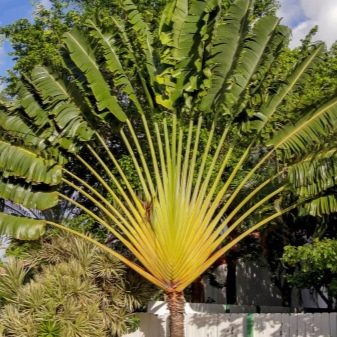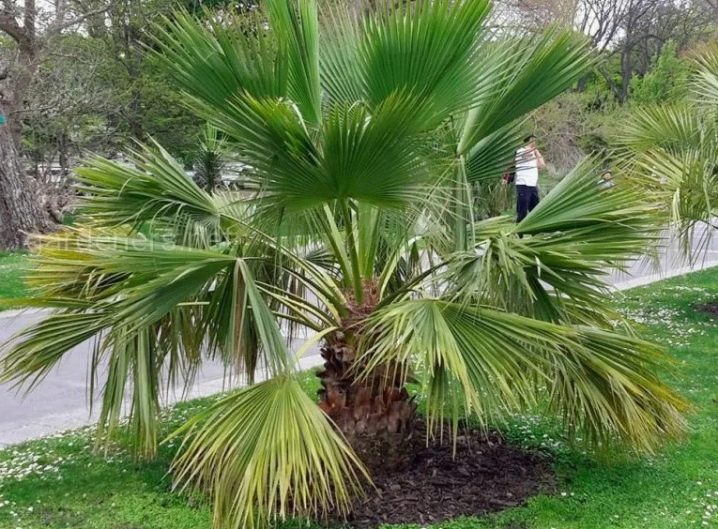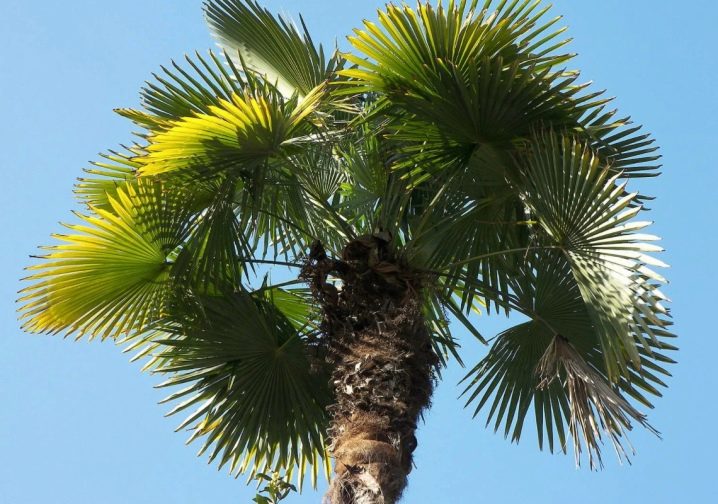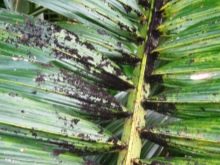What are fan palms and how to grow them?

Fan palms have become very popular lately. They are grown at home and are actively used in interior decoration. These palms look good in large pots that are placed directly on the floor. In order for the plant to look attractive, it must be properly cared for.
general description
The fan palm belongs to the Arekov family. The genus hamerops is monotypic, which means that it includes only one species - the squat hamerops. In the wild, the plant is found in southern Europe and northern Africa. In the open field, the palm tree is actively cultivated in the south of Russia along the Black Sea coast.
The tree reaches a height of 2 meters, but lower specimens are most often found. The lush crown of the tree is made up of many fan-shaped leaves. Each of them contains several large segments with bifurcated ends.


In the upper part of the stems, inflorescences bloom. They are short and fairly dense. Depending on external factors and conditions of detention, flowering occurs from March to June. The components of the seed are the core and several layers of the shell. But, despite this feature, the seeds themselves are quite small.
With age, the trunk of a palm tree becomes covered with small villi. This gives the appearance of the tree a bit of carelessness. Also, as they grow older, some leaves die off, but new ones grow to replace them. In nature, the palm is quite unpretentious. It can be without moisture for a long time under the scorching rays of the sun.
Interesting Facts. There is a belief that when Jesus Christ entered Jerusalem, the locals met him holding branches from this palm tree in their hands. Astrologers say that such palms are recommended for those who want to move up the career ladder.


Popular species and their varieties
There are several varieties of palm trees. Only a few of them are actively cultivated. The varieties are as follows.
- Liviston. The tree requires bright, but diffused sunlight for normal development. The ideal arrangement of such a palm tree at home is the window sills of windows facing the north or west sides.

- Washingtonia, which is characterized by a fairly rapid growth rate. It is quite stable, since it is capable of being at low temperatures down to -12 degrees for a short time. Often used for street decoration in the United States, mainly in the states of California and Florida.

- Rapis Is a bushy plant sometimes called a Chinese or Japanese palm. Unlike previous species, it does not have a clearly marked trunk. This species does not tolerate drought well, so it must be constantly watered and sprayed with a spray bottle in indoor conditions.

- Trachikarpus - a distinctive feature is belonging to long-livers. In its natural habitat, it can exist for up to 150 years. For cultivation from this category, Fortune and Martius are more suitable than others. They prefer to grow in a lighted area, but they do not like direct sunlight.


- Sabal - reaches a height of 2 m, is thermophilic, has a rather thick trunk and a dense crown.

Almost all palms have fruits.Some of them are also actively used in cooking.
Growing care
In order for palms to grow in indoor conditions, they need to create a climate close to natural, that is, subtropical.
Conditions
The air temperature in the room should not fall below +26 degrees Celsius. Of course, if the temperature drops for a few hours, the palm tree will not die. But a systematic violation of the temperature regime will lead to diseases, and possibly death.
The room in which the plant is located should be regularly ventilated. Fan palms prefer soft and fertile soils, as well as timely moisture.


Pruning
Pruning the fan palm is recommended as needed. This should be done as carefully as possible, trying not to harm the plant. As a rule, those branches and leaves are removed that outwardly look unhealthy. Using scissors or pruning shears, you need to carefully cut off diseased and sluggish leaves without touching others.


Transfer
If for some reason the fan palm needs a transplant, then it is better to do it in April or May. Young plants are transplanted almost every year. The procedure is necessary in order to timely replace the pot with a larger container. Otherwise, the root system will develop poorly.
As the palm grows older, the number of transplants is reduced. For middle age, once every 2-3 years is enough, and then you can transplant no more than 1 time in 5 years. At any age, palms are quite painful to undergo a transplant. It is especially not recommended to wiggle the root part. Even minor damage will lead to stunted growth or death.
Long roots should never be pruned. It is better to carefully place them in a new pot, while avoiding fractures.


Top dressing and watering
Palm trees are good for feeding, so you can fertilize the soil twice a month from early spring to mid-autumn. The best option would be mineral fertilizers. In winter, they are fed as needed, but not more often than once a month.
In winter, a period of dormancy begins. The tree stops growing. It is better to move it to a spacious, well-lit room and reduce watering.
If there is too much moisture, the roots will rot. In summer, watering is carried out as the soil dries up.


Reproduction
The simplest and most common way to propagate palms is by seed. Almost any species can be grown from seeds. To do this, the seed is soaked for 24 hours in warm water, and then deepened into a container filled with moist and fertile soil. Germination will occur not earlier than in 2-3 months. All this time, the future palm tree needs to be watered and protected from low temperatures.
Most of the available species also reproduce by cuttings. To do this, you need to take the largest and healthiest shoot, cut it into pieces no longer than 10 cm, and then plant them in moist soil. After a while, the shoot will sprout.



Diseases and pests
If the palm tree is properly looked after at home, then the risk of any disease is minimized. Almost any ailment starts with improper watering. Excessive moisture or, conversely, overdrying of the soil may well become the reasons for the weakening of the plant and the attacks of the following pests.
- False shield and shield. The main symptom of a pest is small brown bumps on the leaves. They feed on plant sap, and if you crush brown droplets, you can see viscous mucus. The first thing to do is to quarantine the plant as pests can attack other flowers. Insecticides in this case will be powerless, because pests have reliable protection in the form of a shell. Best of all, alcohol solutions and water-oil emulsions cope with the shield and false shield.The foliage is processed with solutions, and when the pests begin to feed, they get a severe disorder of the digestive system.
- Red spider mite. This parasite is one of the most dangerous and difficult to remove pests. Feels good in warm and dry air. It attacks most often in the spring. First, it attacks the stem, and then moves to the deciduous part of the palm tree. After the tick is on the palm, brown spots appear. If the plant is not treated, then it will gradually become entangled in cobwebs and die.
- Mealybug. It feeds on sap, attacks the deciduous part and young shoots. It sucks out a large amount of juice, which causes a slowdown or complete cessation of development.
The most common diseases that fan palms suffer from are brown plague, rot, and white leprosy.



In order for pests and diseases to attack palm trees as rarely as possible, important preventive measures must be followed. They are as follows:
- conduct periodic inspection of the palm tree for infection with any disease;
- replanting grown plants regularly;
- when transplanting, rinse the soil with hot water;
- timely cut off dying branches and leaves;
- when new plants appear, observe quarantine measures.
It is very important to take proper care at home. Only keeping in the most comfortable conditions will be a reliable prevention of the development of diseases and pest attacks. Proper care is based on watering, airing the room, choosing a pot that is suitable in volume, spraying the leaves and trunk from a spray bottle, and timely introduction of fertilizers.






































































The comment was sent successfully.